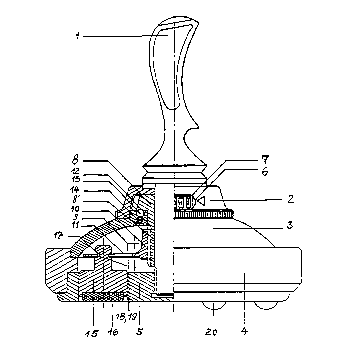Some of the information on this Web page has been provided by external sources. The Government of Canada is not responsible for the accuracy, reliability or currency of the information supplied by external sources. Users wishing to rely upon this information should consult directly with the source of the information. Content provided by external sources is not subject to official languages, privacy and accessibility requirements.
Any discrepancies in the text and image of the Claims and Abstract are due to differing posting times. Text of the Claims and Abstract are posted:
| (12) Patent Application: | (11) CA 2222011 |
|---|---|
| (54) English Title: | CURLING STONE FOR CURLING WITH CONTINUOUSLY VARIABLE GLIDING CHARACTERISTICS |
| (54) French Title: | PIERRE DE CURLING DEMONTRANT DES CARACTERISTIQUES DE GLISSEMENT A REGLAGE CONTINU |
| Status: | Deemed Abandoned and Beyond the Period of Reinstatement - Pending Response to Notice of Disregarded Communication |
| (51) International Patent Classification (IPC): |
|
|---|---|
| (72) Inventors : |
|
| (73) Owners : |
|
| (71) Applicants : |
|
| (74) Agent: | SMART & BIGGAR LP |
| (74) Associate agent: | |
| (45) Issued: | |
| (86) PCT Filing Date: | 1996-05-22 |
| (87) Open to Public Inspection: | 1996-11-28 |
| Availability of licence: | N/A |
| Dedicated to the Public: | N/A |
| (25) Language of filing: | English |
| Patent Cooperation Treaty (PCT): | Yes |
|---|---|
| (86) PCT Filing Number: | PCT/AT1996/000097 |
| (87) International Publication Number: | WO 1996037268 |
| (85) National Entry: | 1997-11-21 |
| (30) Application Priority Data: | ||||||
|---|---|---|---|---|---|---|
|
The present invention relates to an improvement of a curling stone
known from Austrian patent No. 354,921 wherein a support shell (2) provided
with one of more openings (6) for rendering the brake device accessible is
supportively placed between the handle (1) and the housing (3), the support
shell being provided in its upper surface with a central bore. In a preferred
embodiment, the bracket (9) of the brake device is an inherently resilient
support member of star-shaped cross-sectional configuration with preferably
three to six arms (11), radially narrowing slots (18,19) being provided in the
arms (11) for receiving the brake surface supports (15).
Amélioration d'une pierre de curling connue sous le numéro de brevet autrichien 354,921. Une coquille de support (2), présentant une ou plusieurs ouvertures (6) pour rendre le mécanisme de freinage accessible, est placée en appui entre le manche (1) et le boîtier (3), la coquille présentant dans sa surface supérieure un trou central. Selon un modèle préféré, la console (9) du mécanisme de freinage s'avère un support essentiellement élastique de section transversale étoilée et pourvu, de préférence, de trois à six bras (11) présentant des fentes radiales décroissantes (18, 19) servant à recevoir les supports de surface de frein (15).
Note: Claims are shown in the official language in which they were submitted.
Note: Descriptions are shown in the official language in which they were submitted.

2024-08-01:As part of the Next Generation Patents (NGP) transition, the Canadian Patents Database (CPD) now contains a more detailed Event History, which replicates the Event Log of our new back-office solution.
Please note that "Inactive:" events refers to events no longer in use in our new back-office solution.
For a clearer understanding of the status of the application/patent presented on this page, the site Disclaimer , as well as the definitions for Patent , Event History , Maintenance Fee and Payment History should be consulted.
| Description | Date |
|---|---|
| Application Not Reinstated by Deadline | 2000-05-23 |
| Time Limit for Reversal Expired | 2000-05-23 |
| Deemed Abandoned - Failure to Respond to Maintenance Fee Notice | 1999-05-25 |
| Inactive: First IPC assigned | 1998-03-02 |
| Inactive: IPC assigned | 1998-03-02 |
| Classification Modified | 1998-03-02 |
| Inactive: Notice - National entry - No RFE | 1998-02-16 |
| Inactive: Inventor deleted | 1998-02-16 |
| Application Received - PCT | 1998-02-13 |
| Application Published (Open to Public Inspection) | 1996-11-28 |
| Abandonment Date | Reason | Reinstatement Date |
|---|---|---|
| 1999-05-25 |
The last payment was received on 1998-05-21
Note : If the full payment has not been received on or before the date indicated, a further fee may be required which may be one of the following
Please refer to the CIPO Patent Fees web page to see all current fee amounts.
| Fee Type | Anniversary Year | Due Date | Paid Date |
|---|---|---|---|
| Basic national fee - standard | 1997-11-21 | ||
| MF (application, 2nd anniv.) - standard | 02 | 1998-05-22 | 1998-05-21 |
Note: Records showing the ownership history in alphabetical order.
| Current Owners on Record |
|---|
| JOSEF PAUL HERZ |
| Past Owners on Record |
|---|
| None |